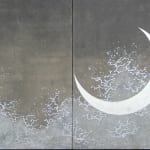Ken Matsubara Japanese, 1948
H180 x W475 x D2 cm
(Set of 4 panels)
Further images
-
(View a larger image of thumbnail 1
)

-
(View a larger image of thumbnail 2
)

-
(View a larger image of thumbnail 3
)

-
(View a larger image of thumbnail 4
)

-
(View a larger image of thumbnail 5
)

-
(View a larger image of thumbnail 6
)

-
(View a larger image of thumbnail 7
)

-
(View a larger image of thumbnail 8
)

As a young man, the famed Buddhist priest Kūkai (774-835) looked out from the Mikurodo cave in Southeast Shikoku where he meditated on the cycle of nature. This legend is the basis for Matsubara’s painting of a crescent moon, capturing the intermediate stage of this celestial body on a set of four sliding doors, or fusuma. Matsubara inscribed Kūkai’s poem Hizō-hōyaku (Precious Key to the Secret Treasury), an exegesis on the tenets of Shingon Buddhism, across the panels. The smooth silver of Matsubara’s crescent moon shines among turbulent waves painted with a clay-resin mixture. Raised lines of mica-based paint accentuate the painting's highly textured surface. The moon’s deep waxing crescent suggests the possibility of new beginnings.







